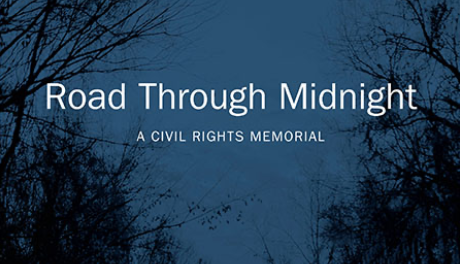Multimedia artist Jessica Ingram explores the South’s racist history in Road Through Midnight
By Kim Green, for Chapter16.org
In the preface of Road Through Midnight, Jessica Ingram writes of a wish to deepen her understanding of America’s racist origins by “illustrating histories of violence and resistance, where often there were no cameras or tape recorders.” With that goal in mind, Ingram spent nearly a decade researching the South’s history of racial terror — traveling to sites where those crimes occurred, recording the testimonies of victims’ families and local journalists, and collecting documents from the era.
The result of her research is a haunting monograph that presents narratives of struggle, injustice, and unspeakable brutality in almost austere fashion. The facts of each story appear, without comment, in white lettering against a black background. To that context, Ingram adds her own findings: yellowed newspaper clippings from libraries and archives, personal letters and snapshots shared by families, edited interview transcripts, excerpts from FBI files, and photographs Ingram took of sites where crimes were committed, where victims lived or worked, or where bodies of the murdered were discovered.

The most wrenching entries are transcribed interviews with survivors, some of whom required years of gentle urging before they would share the full measure of their anger and agony. One of the most devastating of these is with Thomas Moore, whose brother Charles Eddie Moore and friend Henry Hezekiah Dee were kidnapped, beaten, and murdered in Meadville, Mississippi, in 1964 by a notorious Klan cadre called the “Silver Dollar Group.” Both victims were 19 years old.
When Thomas Moore learned that his brother’s body had been found tied up and weighted down in the Mississippi River, he flew home from his Army posting in Texas to arrange the funeral. “The anger began to set in,” says Moore, who told his mother of his plans to steal weapons from the post and “come back and kill everything on the 84 Highway. I will poison the water tank in Meadville and kill everyone in Franklin County. She said you stay in the army. She said the Lord will make a way.”
As in so many such cases, the perpetrators walked free. But decades later, Canadian documentary filmmaker David Rigden asked Thomas Moore to collaborate on a film about the murders. Their investigation and the 2007 documentary ultimately led to the trial and conviction of one of the killers. “I do believe that the dead know what you’re doing,” Moore tells Ingram. “I believe that they are so glad. I believe that Charles Moore and Henry Dee can rest up now.”
Two photographs accompany this entry: One, of a forlorn drive-in restaurant, is the last place Dee and Moore were seen alive. The other, taken in 2009, is of a simple roadside memorial in their honor. The photos are shocking in their ordinariness, places you’d drive by without noticing, washed out to dreariness by harsh midday light.
That such sites exist all over the South reminds us that these extraordinary stories are, in fact, dispiritingly commonplace; most bear no memorial marker at all. There is no signage at a former shoe store in Ferriday, Louisiana, where shop owner Frank Morris was burned alive by Klansmen in 1964. There is no signage at the Tyler-Goodwin Bridge near Montgomery, Alabama, where in 1957 Klan members beat Willie Edwards and forced him to jump to his death. Photographing both places for this book is Ingram’s way of marking the sites.

Road Through Midnight: A Civil Right Memorial
by Jessica Ingram
240 pages
UNC Press Books, 2019
In the afterword, Ingram recalls a flash of insight when she stumbled upon a historical marker at a onetime slave market in Montgomery. But for the sign, she might just as easily have walked blithely by that tragic, haunted place. Ingram was suddenly struck by “what it means to erase histories,” and how important it is for communities living with a legacy of racist violence to see those histories acknowledged. The late Mississippi newspaper editor Stanley Dearman, whose outspoken articles helped call attention to the now-infamous 1964 murders of civil rights workers James Chaney, Andrew Goodman, and Michael Schwerner, told Ingram that he considered these acts of remembrance vital to the healing process: “I think it’s a good thing for the community to do — to look at itself and say this happened.”
For Ingram, who grew up in Nashville, the book is itself a kind of memorial. Her hope was “to reframe these rivers, fields, and homes as markers of struggle.” In showing us how everyday landscapes are forever scarred by violent histories, Ingram is telling us that the wounds of slavery, segregation, and white supremacist ideology survive in ways we refuse to see, in our cities, prisons, schools, and neighborhoods. “The act of marking these sites of injustice in America, of loss of life to racial terror, binds us all,” she concludes. “We must do the work of remembering.”

Kim Green is a Nashville writer and public radio producer, a licensed pilot and flight instructor, and the editor of PursuitMag, a magazine for private investigators.

A Community of Tennessee Writers, Readers & Passersby
All content on Chapter16.org is free to redistribute with the following restrictions: it must be redistributed in its entirety and attribution must be given to Chapter 16. Also, the content may not be redistributed for commercial purposes. This work is licensed under the Creative Commons Attribution-NonCommercial-NoDerivatives 4.0 International License. To view a copy of this license, visit creativecommons.org.

